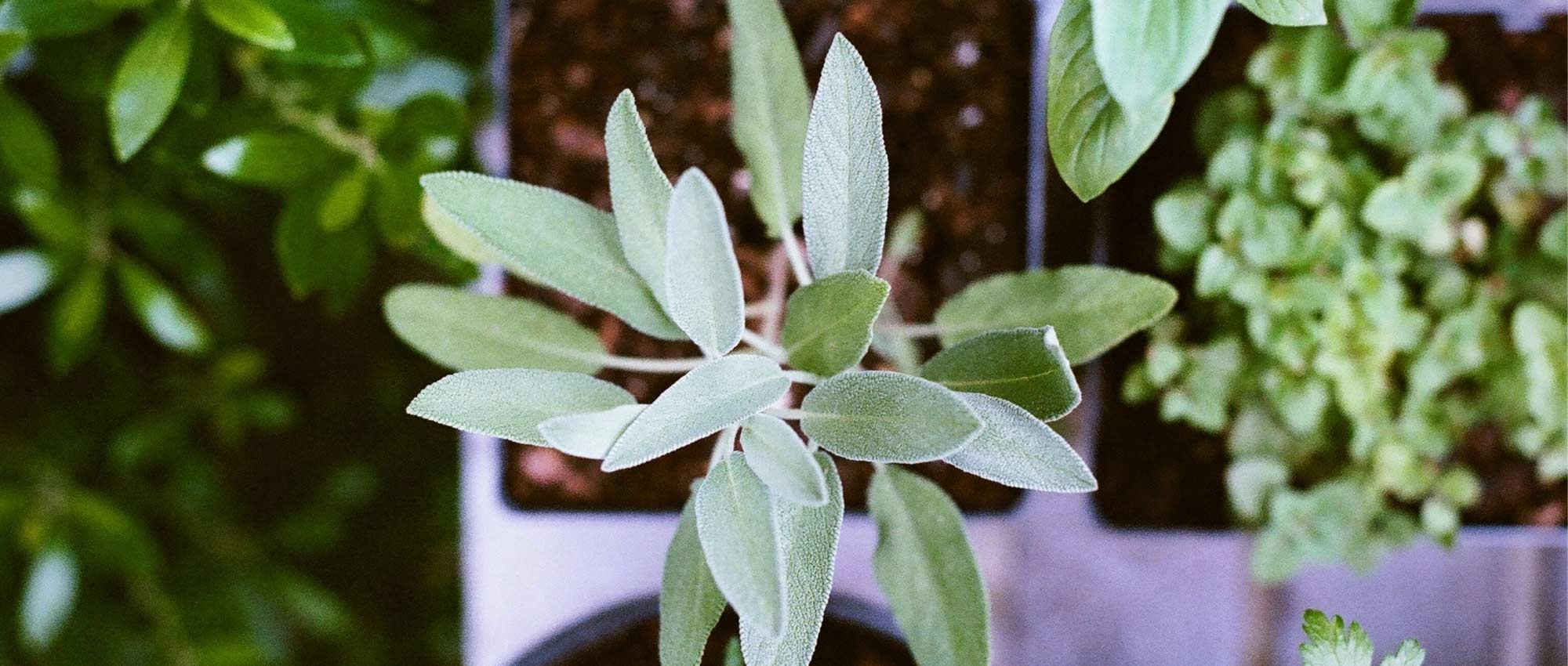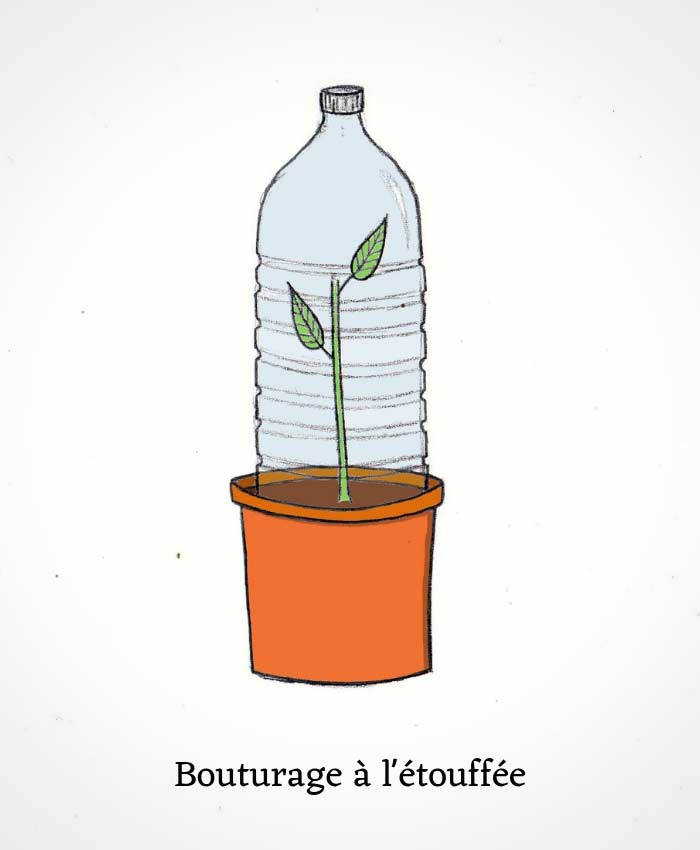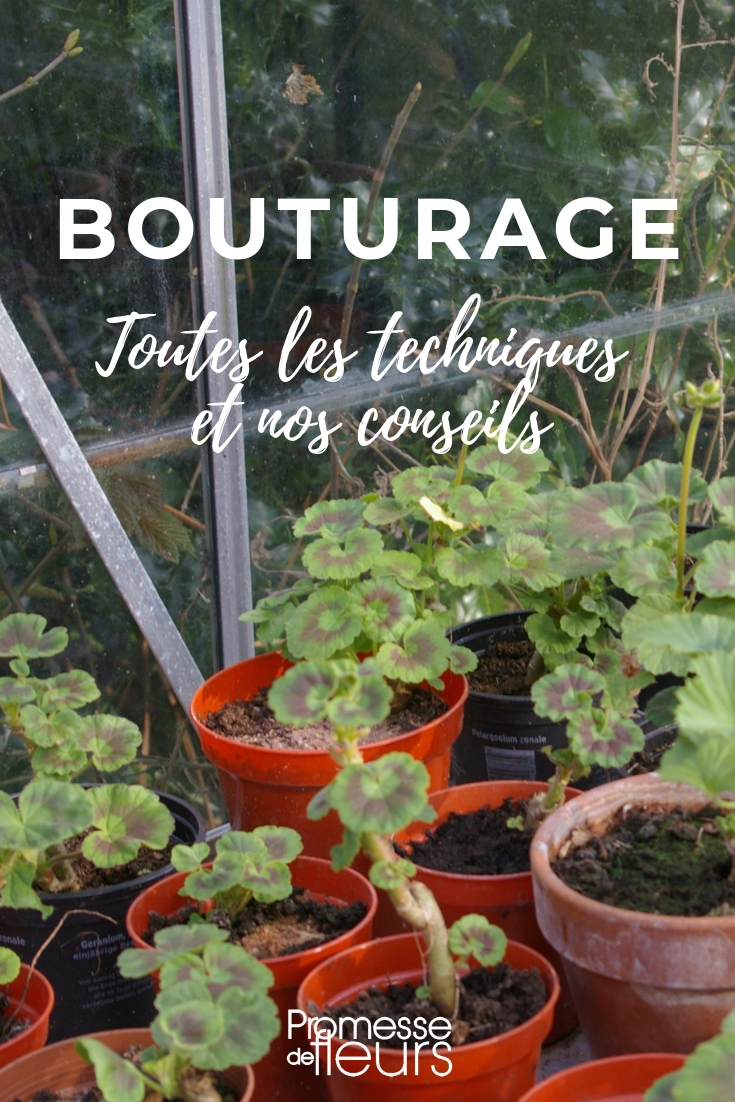
Propagation by cuttings: everything you need to know about the different techniques and our tips
to easily propagate your plants
Contents
Propagation by cuttings is an effective, fairly simple, and quick technique for multiplying plants. Unlike sowing, the plant obtained is strictly identical to the original specimen… it is, in a way, a “clone”. This technique is therefore particularly interesting for multiplying horticultural varieties, which, otherwise, could lose their characteristics when reproduced by sowing (colours and shapes may vary…). With propagation by cuttings, we exploit one of the remarkable features of plants: the exceptional ability to recreate a complete being from a simple fragment (stem, root, leaf…)! Discover all our tips for successfully propagating your plants: when to propagate, which technique to use, what conditions improve the success rate…? And to get started, feel free to check out our selection of 15 very easy plants to propagate!
When to propagate? The calendar
To successfully take cuttings, it is essential to use the right technique at the right time, following this schedule:
- Herbaceous cuttings are taken in spring, usually in May-June, from green, young, and tender stems.
- Semi-woody cuttings are made in mid to late summer, from July to the end of September.
- Hardwood cuttings are taken in late autumn and winter, between November and February.
- Leaf cuttings can be taken throughout the year, but the most favourable times are spring and early summer.
- Root cuttings are taken when the plant is in dormancy, in late autumn and winter.
Read also
15 very easy plants to propagateMaking cuttings: general information and preliminary advice
In all cases, before taking cuttings, make sure to use clean, sharp tools to avoid transmitting diseases. Similarly, it is important to make clean cuts.
Choose healthy, well-formed stems (or leaves, roots…) without signs of disease. They should not have flower buds, flowers, or fruits (if they do, remove them, as this takes energy away from the cutting, which should focus on root development rather than flowering or fruiting).
You can use plant hormone to encourage rooting. Simply dip the base of the cutting in the plant hormone.
It is important to use a well-draining, light, and airy substrate. This can be made up of potting soil and sand, or potting soil and perlite. If you use a substrate that is too heavy, compact, and retains water, the cutting may rot.
Once the propagation is done, ensure that the substrate remains slightly moist (it should not dry out), but not waterlogged, and that it is in a bright location. Cuttings need warmth, humidity, and light. They should be protected from cold and direct sunlight. Excess humidity should also be avoided, as this can cause them to rot.
Cuttings are often placed “under glass,” by covering them with a plastic bottle or plastic bag to maintain a humidity-saturated atmosphere.
Propagation by cuttings of stems
This is the simplest and most common technique. Generally, segments measuring between 10 and 15 cm in length are chosen (but this can vary depending on the selected plant!), and the plant is cut just below a node, then the stem is replanted in soil.
Herbaceous Cuttings
Herbaceous cuttings are taken in spring, usually in May-June, from green, young, and tender stems. This is the simplest and most basic technique, allowing for the multiplication of many perennials. You can propagate Pelargonium and hardy geraniums (notably G. macrorrhizum), Asters, Hybrid Verbenas, Clematis, Penstemon, Campanulas, Salvias…
- Take a stem, 10 to 15 cm long, cutting just below a node.
- Remove the basal leaves, leaving only two or three at the top of the stem (if they are very large, you can cut them back to reduce their surface area). Similarly, if there are flower buds, flowers, or fruits, remove them.
- Prepare a pot with light potting mix. Water it to ensure it is moist.
- Optionally, dip the base of the stem in rooting hormone.
- Make a small hole in the potting mix using, for example, a pencil.
- Plant the stem in the hole, then firm the soil around it to ensure good contact between the stem and the substrate.
- Place the pot in a sheltered location, in a bright spot, out of direct sunlight.
- You can cover the cutting with a transparent plastic bag or a plastic bottle to maintain a humid atmosphere.
… All you have to do now is wait!

To perform stem cuttings: 1/ Cut a stem just below a node. 2/ Remove the basal leaves. 3/ Place the cutting in soil. 4/ Ensure the substrate remains slightly moist by watering occasionally.
Discover our video tips for propagating Pelargonium:
Semi-Woody Cuttings
This technique is practiced in mid to late summer, around July-August, or even September. It is mainly used for shrubs and plants that become woody (produce “wood”), by taking shoots from the current year that have begun to harden and lignify at the base. This is also referred to as semi-ripe cuttings. Many shrubs can be propagated this way, including hibiscus, hydrangeas, euonymus, bignonia, photinia, oleander, honeysuckle, privet, buddleia, abelia…
- Take stems that are still tender at the tip and slightly lignified at the base (firm, brown). Cut just below a node to obtain segments measuring between 10 and 15 cm in length. You can optionally take it with a heel, the base of the shoot from which it grows. If there are leaves on the lower part of the stem, remove them.
- Dip the base of the stem in rooting hormone.
- Plant it in a pot filled with light substrate.
- Place the pot in a sheltered location, in a bright spot, out of direct sunlight. You can also cover the cutting.
Hardwood Cuttings
This technique allows for the multiplication of trees and shrubs. It is carried out when the plant is dormant and has lost its leaves, between November and February.
- We recommend starting by preparing the ground. Choose a location sheltered from wind and direct sunlight (for example, in front of a north-facing wall), then dig a trench and add some sand for drainage.
- Next, cut cuttings, 15 to 20 cm long, taken from well-formed, disease-free shoots of the current year. Cut the base at an angle just below a node; and the top of the cutting, above a node as well.
- Plant the cuttings in the trench (you can plant them individually or group them in small bundles).
- Replace the substrate and firm it all around.
- By the end of March, you can replant the cuttings in a nursery or pot them up.
Instead of planting the cuttings in the ground outside, it is possible to plant them in pots that you place under a cold frame.
Discover our video tutorial and Olivier’s tips:
Read also
10 tips for gardening on a budgetPropagation by cuttings of leaves
This technique is well suited for succulent plants with fleshy leaves (sedums, kalanchoe, crassula, echeveria…), as well as for many houseplants: Peperomia, Saintpaulia, Begonia rex, Sanseveria… Eucomis can also be propagated by leaf cuttings. It can be done throughout the year, but the most favourable times are spring and early summer.
- Prepare a pot by filling it with a light, well-draining substrate (a mix of potting soil and sand). Water it.
- Take a leaf, keeping its petiole. Choose a young, healthy leaf that is free from diseases or pests.
- Then make a hole in the potting soil and plant the petiole, up to the base of the lamina.
- Firm the soil well around it.
- Place the pot in a heated shelter at about 20 °C, out of direct sunlight.

To propagate leaves: Take a leaf by cutting its petiole at the base, then implant it in a well-draining substrate.
For some plants, only a segment of the leaf will be used (Sanseveria, Eucomis, Begonia, Streptocarpus…), rather than the whole leaf with its petiole. The segment should then be planted vertically in the substrate.
For succulent plants, allow the leaf to dry for two or three days before potting it.
Finally, for certain plants (Begonia, Gloxinia…), you can make incisions on the underside of the leaf, along the veins, and then lay the leaf on the potting soil. The leaf should produce new roots at the incision points.

Leaf cuttings work well with fleshy plants. Here, an Echeveria setosa (Stephen Boisvert), and another species of Echeveria, developing seedlings at the base of a leaf.
Root propagation
Certain plants can be propagated by root cuttings. Roots are taken while the plant is in dormancy, at rest, therefore in late autumn and winter. This technique works well on plants that naturally produce suckers, as well as those with thick roots. You can propagate in this way Phlox, Oriental Poppies, Acanthus, Echinops, Eryngiums, Japanese Anemones, Verbascum, Kerria japonica, Aralia, Virginia Sumac, Lilacs, Raspberries, and Blackberries…
- To propagate the roots, start by selecting a healthy, vigorous clump. Taking some of its roots may slightly weaken it. Avoid choosing sickly or weak plants; also, avoid taking too many roots from a single plant…
- Dig to unearth the original plant and expose the root system.
- Identify young, thick roots, then cut sections measuring between 6 and 12 cm in length (thick roots can be cut shorter than thinner ones), using a sharp, disinfected knife.
- Replant the original plant immediately.
- Prepare a pot with a mix of potting soil and sand.
- Place the root sections in the pot. If the roots are thin, lay them horizontally and cover with about 1 cm of substrate. If they are thick, position them vertically, with the top of the root just at soil level.
- Water lightly.
- Place the pot in a cold frame, out of direct sunlight.
- Ensure the substrate remains slightly moist, watering occasionally if necessary.
The cuttings should start to grow in spring.
For example, check out our video tips for propagating Oriental Poppies from their roots:
Some specific techniques and additional tips
- Propagating by cuttings under a plastic cover?
Propagation by cuttings under a plastic cover simply involves placing a plastic bag or a plastic bottle (or another transparent glass or plastic object) to create a humid atmosphere around the cutting. This encourages the plant to take root by creating truly favourable conditions and preventing it from drying out. However, we recommend airing it out from time to time (for example, every three days) and ensuring that the plant does not touch the wall to prevent it from rotting. Also, avoid placing it in direct sunlight!
 To propagate by cuttings under a plastic cover, you can use a bottle, but also a plastic bag or any other transparent element that helps retain moisture.
To propagate by cuttings under a plastic cover, you can use a bottle, but also a plastic bag or any other transparent element that helps retain moisture.
- Propagating in water?
This technique has the advantage of being very simple as it involves simply placing the stem in water and waiting for it to produce roots before repotting. The downside is that the plant often has more difficulty adapting once it is potted in soil. Its roots have become accustomed to water and are less suited to soil. Nevertheless, this technique works well for papyrus, willow, mint, and oleander… Apart from these species, for the majority of plants, we recommend propagating directly in potting soil.
In general, if you use this technique, avoid leaving the plant in water for too long… It is also advisable to place a piece of charcoal in the water (this helps keep the water clear and prevents the stem from rotting).
Learn more in our articles: How to easily propagate plants in water? and Which plants can be propagated in water?
- Using rooting hormones?
Rooting hormone facilitates rooting while allowing for better healing and limiting the onset of diseases. While not essential, many plants can be propagated without rooting hormone, but its use remains beneficial for certain difficult-to-propagate plants. You can also make a natural substitute called “Willow Water” by using willow branches that you place in water for several weeks.
- Heel cuttings?
This is an alternative technique to simple stem cuttings, used for propagating trees and bushes. A stem is taken along with a small segment of the branch from which it is inserted. The base of this stem is valuable to keep as it contains meristems that promote root growth, thus improving the plant’s chances of survival.
Another similar alternative technique is the crozier cutting. Here, a stem with a true section (between 1 and 2 cm long) of the branch from which it is inserted is taken, forming a T-shape. This technique works well for cistus, elder, olive, fig, vine, berberis, and strawberry trees…

To discover
Discover all our other tips on propagation by cuttings:
- Subscribe!
- Contents
































Comments